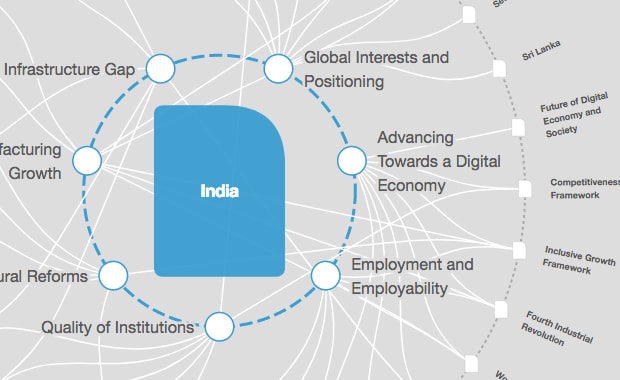Here's why forest restoration is key to India's ambitious climate goals

Forest landscapes, such as this one in the north-eastern state of Meghalaya, are at the heart of India's ambitious climate commitments. Image: 1t.org
Nicole Schwab
Co-Head, Nature Positive Pillar; Member of the Executive Committee, World Economic Forum- India has committed to create an additional carbon sink of 2.5-3 billion tonnes of CO2 equivalent through additional forest and tree cover.
- This means increasing its forest cover from the current 25% to 33% and restoring 26 million hectares of land by 2030.
- The World Economic Forum’s trillion trees initiative is launching the 1t.org India Platform to support these efforts.
In the dense forests of the Siwalik mountains at the foothills of the Himalaya, the gray langur monkey gives a warning call to his fellow dwellers that a tiger is on the move. India is home to 80% of tigers in the world and has shown significant progress in the conservation of the species, with more than 50 protected areas. Protecting the tiger means protecting and restoring its habitat, which links directly to the country’s international commitments under the Paris Agreement on climate change, and the UN convention to combat desertification.
India has a long tradition of community participation in the conservation and restoration of trees and forests, from the Bishnoi people in the country’s arid state of Rajasthan who gave their lives to save their forest more than two centuries ago, to the women of the Himalayan state of Uttarakhand who mobilised the Chipko movement in the 1970s. This abiding commitment to their natural landscapes drives urban Indians to rally for their city’s green cover in the tech-capital Bengaluru, and inspires philanthropists to support the conservation of mangroves in India’s financial capital Mumbai.
India is the only G20 nation that is well on track to achieve its Paris Agreement climate goals. Yet the scale of the challenge is not to be underestimated. At 1.4 billion, India’s population is the second largest in the world, but its landmass is less than 3% of the earth’s surface. A developing economy with an increasingly young population, India’s challenge is to adopt a net-zero, nature-positive development pathway that can meet the needs of its citizens, while mitigating climate change and safeguarding its ecosystem for future generations.
Forest landscapes are at the heart of the country’s commitments. It plans to create an additional carbon sink of 2.5 to 3 billion tonnes of CO2 equivalent through forest and tree cover; to increase forest cover from 25% at present to 33%; and to restore 26 million hectares of land by 2030. Through the Green India Mission and National Afforestation Program, the Government of India is creating impetus for action on the ground. A number of leading Indian companies are adopting environmental, social and governance (ESG) strategies and investing in trees and forests. From sectors as diverse as technology, renewable energy, consumer goods, infrastructure, logistics, and healthcare, companies have taken action, often in collaboration with others.

The World Economic Forum’s trillion trees initiative has launched its 1t.org India Platform to support these efforts. Drawing on 1t.org's work across several continents from the Amazon to North America, the Sahel, Europe and China, we will build on existing efforts in the country to facilitate a multi-stakeholder action agenda. Our focus will be on encouraging ecopreneurship, spotlighting and scaling promising innovations and solutions, engaging the Indian private sector to commit resources and know-how for forest restoration and reforestation, and facilitating public-private collaboration.
As one of its first activities, the 1t.org India Platform, in collaboration with UpLink, launched a Trillion Trees: India Challenge to showcase and spotlight a new generation of grassroots innovators and ecopreneurs who are developing solutions and putting forest conservation and landscape restoration at the heart of their business models. We are proud to announce the first cohort of 13 ecopreneurs and innovators whose solutions will help to support the country’s overarching forest conservation and restoration goals.
What’s the World Economic Forum doing about deforestation?
The Government of India and sub-national governments have also articulated their land restoration and conservation goals. Through a variety of funding, as well as capacity-building measures, the public sector is incentivising ecopreneurship and sustainable business practices.
In the coming months, we will collaborate with private, public and civil society actors to encourage action at scale in support of India’s international commitments, as part of our support for the UN Decade on Ecosystem Restoration. It is only with the support of all stakeholders working in collaboration that tiger habitats and the broader Indian ecosystem will continue to thrive, and our forest landscapes can provide the ecosystem services humans need for generations to come.
Don't miss any update on this topic
Create a free account and access your personalized content collection with our latest publications and analyses.
License and Republishing
World Economic Forum articles may be republished in accordance with the Creative Commons Attribution-NonCommercial-NoDerivatives 4.0 International Public License, and in accordance with our Terms of Use.
The views expressed in this article are those of the author alone and not the World Economic Forum.
Stay up to date:
One Trillion Trees
Related topics:
Forum Stories newsletter
Bringing you weekly curated insights and analysis on the global issues that matter.
More on Geographies in DepthSee all
John Letzing
January 27, 2025






